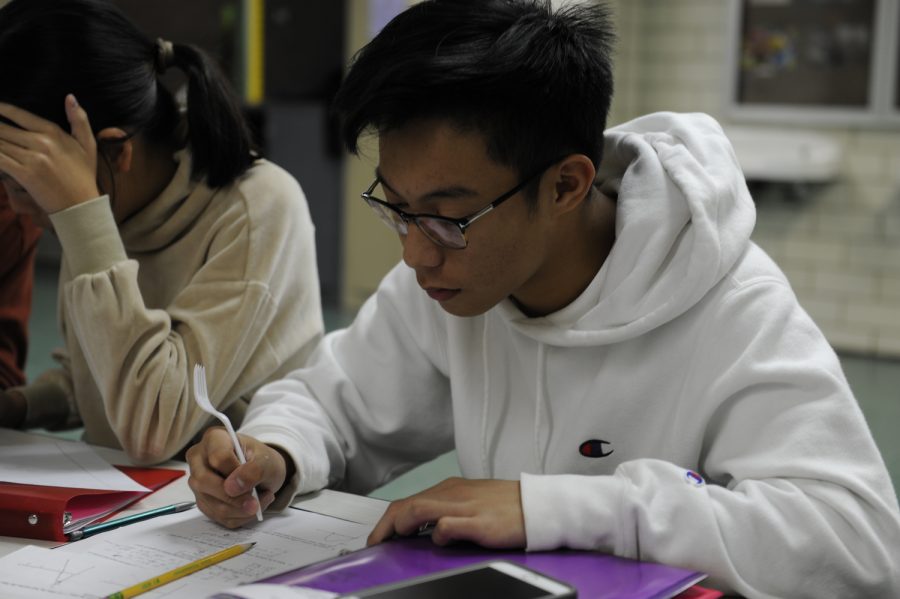Why Students Aren’t Eating Healthy Foods
A student spends his lunch period doing homework, holding a pencil instead of a fork.
When Bronx Science students leave school to grab a quick bite, the first thing they see are three food trucks – Jay’s, Michelle’s, Ned’s – all selling almost exclusively fast food. With students largely eating breakfast, lunch, and snacks at school, they are pushed into choosing these food truck foods if they wish to eat any fare outside of the school, due to their location.
According to the Center for Disease Control (CDC), over one third of children and adolescents in America consume fast food, which is notoriously high in sodium, saturated fat, trans fat, and cholesterol, on any given day. Too much fast food consumption increases the chances of developing high blood pressure, heart disease, and obesity. These conditions have become increasingly prevalent in recent years; the CDC reports that in the United States today, one in five children and adolescents are obese.
“A healthy diet would involve three meals a day, but I don’t think I will ever have this diet,” said Cristine An ’22.
The increased popularity of fast food has another unintended consequence. Nationwide, our students, despite consuming more calories, are more deprived of vital nutrients than ever before. Fast food does not offer many of the vitamins and minerals necessary for a healthy diet, and teens have been skipping more nutritionally diverse meals in favor of an order of burgers and fries.
This trend is especially apparent here at Bronx Science. With the added stress of attending a specialized high school, due to the increased rigor of students’ course loads, many students have less than ideal eating schedules. For commuting students, some of whom live up to two hours away, breakfast is often skipped in order to catch up on more sleep.
Some students use their lunch periods in order to study or to complete homework, while others may drop lunch in order to take extra classes. Given the lack of time in their schedules, it is not a surprise some students do not consume the recommended two thousand calories per day. “I eat two meals a day,” Cristine An ’22 said. “A healthy diet would involve three meals a day, but I don’t think I will ever have this diet.”
Although An does not report eating fast food, the same cannot be said for many Bronx Science students. Of those who manage to eat the three recommended meals a day, usually at least one will have been purchased from the various food trucks in front of the school.
One such student is Syed Sharif Hassan ’21. “I try not to eat fast food or chips or stuff like that,” he said, leaning over an order of fries from Michelle’s, “but I can’t make my own food in the mornings.”
For the students who make sure that they consume enough food, they tend to think less about the quality of food they are eating and more about quantity. Fast food is readily available in a variety of sizes, with even the largest order of fries costing a fraction of the cost of a salad. In order to promote healthy eating, healthier food options must be made more readily available for students living on a limited budget, in New York City and throughout the nation.
One solution to this growing issue could be the distribution of to-go lunch packs at Bronx Science and at other schools nationwide that have students with more intense academic schedules. Paper bags with a carton of milk, a sandwich, and fruit could be made available for pickup throughout the day. This would allow students to grab a lunch so that they could eat discreetly in class as an alternative to the food trucks’ selection of fast food. At Bronx Science, in conjunction with the mandatory health course and the free school lunch for all students, this could prove to be an effective measure in encouraging more students to eat a nutritious lunch.
Securing the health of children and adolescents means securing a brighter future for all. If ensuring the basic physical well-being of the youngest populations fails, then it will be more difficult for them to live healthily as adults. Without happy and healthy adults, a brighter future that is desired for all will be forever lost.
Jing Mae Wang is a Copy Chief Editor for ‘The Science Survey’ and an Academics Section Reporter for ‘The Observatory.’ The students of Bronx Science...
Gazi Fuad is a Chief Photographer & Photo Editor for the school yearbook ‘The Observatory.’ Outside of school, he is part of a team of photographers....

